|
Scalping
- Rhyme & Reason
Did
you know that scalping was done for spiritual reasons? It was
thought by most Tribes that if you disfigured a person in battle,
then that person could not enter the Spirit World. They also
believed, like many cultures do, that one's Spirit is contained
in the hair. When they heard about scalping it seemed an obvious
addition to their battlefield practices. Instead of cutting
the body of an enemy they took some of the hair, and in doing
so captured the person's Spirit. Therefore the Spirit could
not move on.
Instead
of taking the whole scalp as white people used to, a Warrior
would take only a small lock. This piece of hair would often
be ornately dressed with beads, feathers, and personal power
items. It would be braided and was exclusively there for an
enemy to take in battle. It was actually called a 'scalp lock'.
The enemy warrior would hold the braid and cut around the base
of the lock and then quickly pull up hard so that the area would
come away. By doing it this way it didn't necessarily kill.
The braver the warrior was, the more power would be with the
taker of the scalp. Sometimes the scalps would be used in ornamentation,
on clothing, shields or tipi's. Some were given to the women
to use, some were kept by the warrior. Often the scalp was treated
with the utmost respect, and eventually burned to release the
Spirit so that it could continue its' journey.
(From
Beads & Buckskins - Men's role: Warrior & Weapons talks.)

The
Medicine Wheel
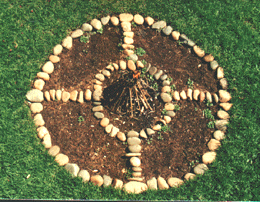
The
Medicine Wheel is an archaic system of Earth Astrology. Each
point on the wheel depicts a different stage of life, and is
represented by a color, a creature, a direction and Spirit.
Medicine Wheels have been found all over the world, they are
not exclusive to North America. Stonehenge the monolithic temple
in England which is said to date back to 2,000 BC, is in actual
fact a form of Medicine Wheel.
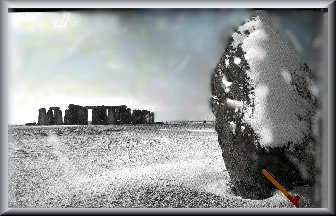
Stonehenge,
England.
A
friend in South Africa has a beautiful Medicine Wheel in her
back yard, which also happens to be the Bush. She goes there
almost every day to pray, she often has four leggeds and winged
ones joining her at her prayers. As the photo below shows.
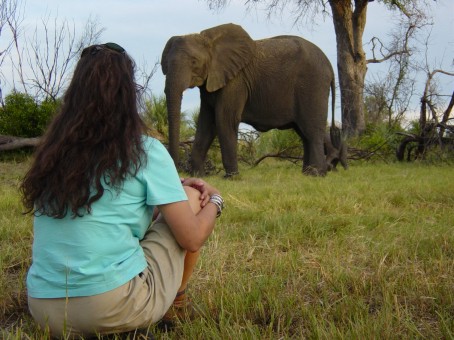
Where
ever you go be respectful, that is the rule that we live by.
(From Beads & Buckskins - Symbols, Crafts & Spirituality
talks.)

The
Talking Stick
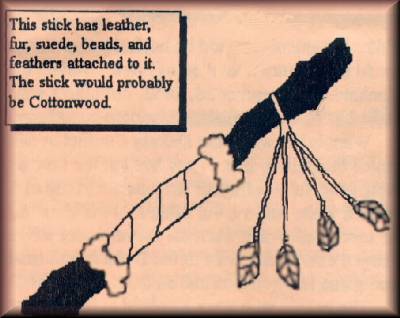
The
Talking Stick was used in tribal Council sessions. It was passed
around the circle, and only the person in possession of the
stick was allowed to speak. That way each person present could
put their thoughts forward without being interrupted. After
all the words had been spoken the decision maker would give
their own determination, knowing that everyone present had had
a chance to have their say and taking their words into consideration.
It was a democratic way for laws and rulings to be made. We
often say that we should send a couple of Talking Sticks to
Washington for the Senate and Congress to use. Probably every
Government in the world could use one!
Today
the Sticks are used in more contemporary ways. In 12 step programs,
especially in the abuse sessions they are an asset, because
people can say what they feel and know that they will not be
interrupted or put down. In families they are useful, the kids
are allowed to speak, and the parents have to listen, and of
course it works both ways!
(From
Beads & Buckskins - Crafts & Social customs talks.)

Tipi?
Wigwam? Longhouse?
After speaking with many people we find that there
is confusion as to what the housing structures should be called.
Here we will try to rectify that confusion.

This
is a Wigwam. It is made of bark, poles and sticks.
This
type of dwelling comes from the north east tribes, It is a single
family dwelling.
As
you can see it is nothing like a tipi. Most Woodlands tribes
used this type of home. The wigwam can be either conical or
domed. The Dakota used these as a temporary home while they
were collecting the sap of the maple tree which we know today
as Maple Syrup. The Dakota and Ojibwa people knew the job as
'Sugaring', and it was a way for them to get a sweetness that
their body could absorb naturally. The sugar that we have causes
them to become sick.
Good
information about the Wigwam is given HERE
Plains
Tipi
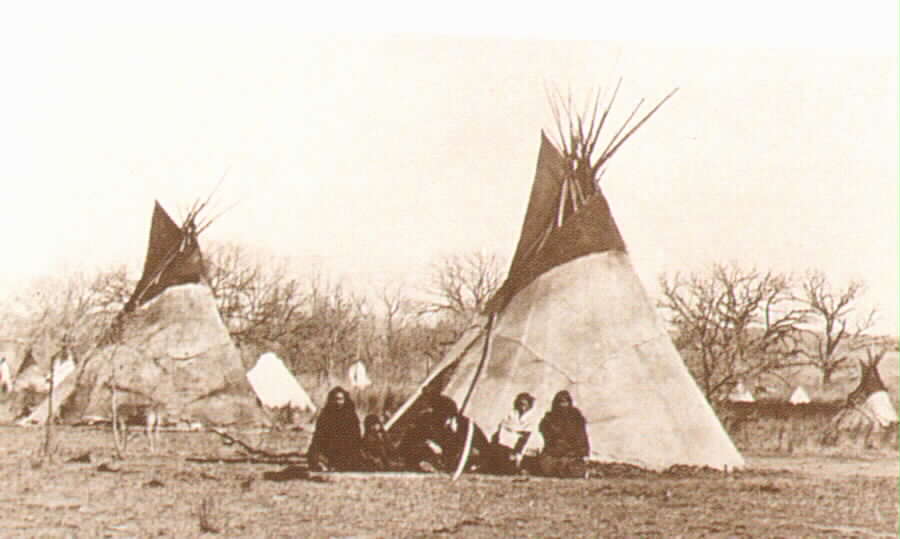
These
are Tipis. Made out of Buffalo hides.
Used
by Plains tribes. Easy to put up and take down. The tipi belonged
to the women, and she would take care of erecting it, keeping
it repaired and dismantling it. It could take all of three minutes
to take one down!
The
hides were all scraped by hand by the women, and boy that was
hard work....we know because we did one. We used old traditional
tools, basically sharpened stones. We admire the women of yester-year
much more since doing that.
As
you can see from this photo the tipis were set up in a circle,
their doorways facing east, The poles were set up in such a
way that they were very safe even in very high winds. In winter
the tipi was warm and in summer cool. In each of these dwellings
lived whole families sometimes 6 to 8 people, three generations
all under the same roof! Can you imagine that happening today,
with all the things we accumulate?
Our
tipi is shown on the header on each page of the site.
Longhouse

An
Iroquois village was made up of one or more longhouses, surrounded
by a woven palisade. The long houses ranged in length from about
60 feet to well over 220 feet, and were generally about 20 feet
wide and 20 feet high. The framework of a longhouse resembled
a large rigid basket made of wooden posts set into the ground,
with other poles and saplings lashed to these to form the exterior
walls and create the arched roof. A variety of trees were used
to construct the framework: decay-resistant woods chosen for
the posts and poles set into the ground; strong, and sometimes
flexible woods chosen for the remainder of the framework. The
bark was probably peeled from these posts, poles, and saplings,
so that they would be less likely to harbor insect pests.
Bark
from various kinds of trees was used to cover the framework,
for interior partitions, and for the benches and shelves of
the living space. Among the New York Iroquois, elm bark was
preferred. Large sheets of bark were lashed to the exterior
walls and roof of the longhouse. The Iroquois smoothed the rough
outer bark surfaces, so that water would run off of them more
easily.
©The
Iroquois Longhouse, A Mohawk Iroquois Village, c.1600.
New York State Museum, Albany, NY
you
can see more pictures and information on the Longhouse HERE
(From
Beads & Buckskins - Tipi, Marriage, Female role talks.)
The
previous sections are excerpts from our 'Beads & Buckskins'
program, which is detailed here

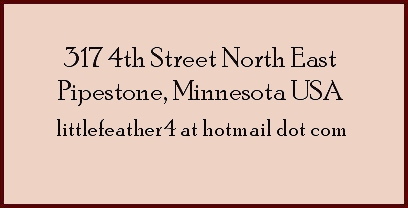


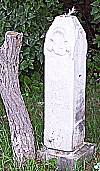
Grave of Chuck's Great, Great Grandfather that we found last
week in Sisseton.
He was a scout in the 1860's.



|











